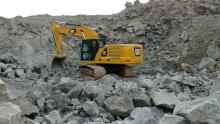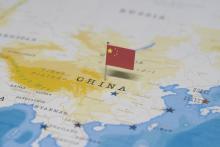Central Asia’s five republics are rapidly growing their transport and other infrastructure, creating eye-catching opportunities for global building materials suppliers and aggregates handling and processing equipment manufacturers. Guy Woodford reports.
Close observers of geopolitics and emerging market economics will have noted how the five Central Asian republics - Uzbekistan (population 31 million), Kazakhstan (18 million), Tajikistan (9 million), Kyrgyzstan (6 million), and Turkmenistan (6 million) – are pivotal to the successful delivery of China’s epic Belt and Road Initiative (BRI), a US$5-trillion mega-infrastructure project across Europe, Asia, the Middle East and Africa.
Colloquially known as the ‘Stans’, a suffix meaning ‘lands of,’ the Central Asia republics are endowed with tremendous natural resources. Among their wealth of commodities are hydrocarbons – oil and gas, as well as coal – which form the cornerstones of the economies of Kazakhstan, Turkmenistan, and Uzbekistan.
The Asian Development Bank (ADB) estimates that US$33 billion per year will be needed between 2016 and 2030 to tackle the massive infrastructure requirements of Central Asia. While some of this investment is required to replace the republics’ inherited decrepit Soviet-era transport infrastructure network, there is also a hunger among Central Asian people for greater connectivity with the wider world, to be a region to do business with and holiday in. Central Asia’s republics are lands of opportunity and an increasing draw for growth-seeking global commerce, including major building materials and mineral processing equipment manufacturers.
In an interview with this magazine in autumn 2016, Professor John Read,
“These are regions that do not have a developed road network. To enable them to get to the same living standards we have today, we expect them to follow on in terms of massive investment in road networks from the BRIC [Brazil, Russia, India and China] countries. After the Central Asia republics, it will be Africa’s turn, specifically countries such as South Africa, Kenya, Egypt, Tunisia, Morocco, and Algeria – coastal locations exposed to the wider world. These will be followed by some internal African countries. A lot of
During the same ABI interview, Read said that in his role at Shell Bitumen, he has worked closely with the World Bank on sustainability projects in various countries.
“The World Bank used to say, and may still do, that it was better for them to invest a dollar in roads, than a dollar in irrigation. If you connect two villages, they begin to trade. That creates wealth, and that wealth is used to purchase goods. Then you create the next village road and trade link.”
A new report titled Construction in Kazakhstan - Key Trends and Opportunities to 2022 by GlobalData, a leading global business market research consultancy, says the Kazakh government’s efforts to enhance transport and residential infrastructure will support the growth of the construction industry until 2022. The report highlights how the government plans to invest KZT6.5 trillion (US$20 billion) to develop Kazakhstan’s rail and road infrastructure. In addition, the government’s aim to develop renewable energy resources is expected to support investment in energy infrastructure projects, which will in turn fuel growth in the industry. The industry growth will also be driven, says GlobalData, by the Strategic Development Plan 2025, under which the Kazakh government aims to improve the competitiveness of business and human capital, institutional environment and technological modernisation, thus ensuring sustainable economic growth.
Ling says that as well as BRI generating huge demand for aggregates in Almaty, Kazakhstan, and other cities and regions in the Stan republics, there are some other ongoing big transport and residential building infrastructure projects. These include 1000 kilometres (kms) of new road from the Almaty region to East Kazakhstan; a further 1200kms of new roads between the Almaty region and the Kazakh capital of Astana, the delivery of Kazakhstan’s 2020 Economically Affordable Housing Plan; and major civil construction works in southern Kazakhstan. Other projects include the expansion of the impressive metro rail network in Tashkent, capital of Uzbekistan.
Speaking about Central Asian republics’ aggregates sector customers’ equipment preferences, Ling says: “We find that wheeled loaders with a 5-tonne bucket capacity are popular among medium- to small-size quarry operators. Wheeled loaders with bucket capacities of seven to nine tonnes are liked by larger quarry businesses.
“Overall, with a deepening of support from the Chinese government for the Belt and Road Initiative, there will be more projects and better prospects for the Central Asian republics’ aggregates sector.”
A spokesperson for
“Metso has been operating for many years in Kazakhstan and Uzbekistan, and in parts of Tajikistan and Kyrgyzstan,” says Alexy Strikha, Metso’s Central Asia regional director. “The highest numbers of aggregates production are in Kazakhstan and Uzbekistan. The Kazakhstan market has experienced considerable growth during the last few years and has now stabilised. The Uzbekistan market is emerging and for the moment has the highest potential for growth among the countries in the region.”
Strikha says Metso puts Kazakhstan’s aggregates production capability to be up to 60 million m³, while the current demand is around 35 million m³. Estimating other Central Asian republics’ production volumes is, says Strikha, difficult due to variations in the recording of official statistics.
Commenting on the main types of aggregates produced in Central Asia and their usual buyers, Strikha says: “The main source for construction material is gravel that is mined around large cities or construction areas. Most of the end customers are large construction companies that are active in segments such as road construction, house construction and major industrial structures.
“Aggregates produced in Central Asia are predominantly domestically consumed due to growing logistics expenses.”
Analysing some of the big infrastructure projects taking place within the five Central Asian republics, Strikha continues: “The Uzbekistan market is growing with projects like construction of business centres, for example Tashkent city with US$1 billion investment in construction. The plan is to build by 2020 around 500 apartment buildings in the Tashkent region and 500 hotels in the whole country.
“One of the main road construction projects in Uzbekistan is the Tashkent-Samarkand highway, which is planned to be built within the next few years. The country also has a few industrial construction projects, like refinery and automotive manufacturing.
“Kazakhstan finalised big infrastructure projects in 2017 like Astana Expo and Nurly Zhol. Nowadays, construction volumes there are reduced.”
Strikha says that due to Central Asia republic mining and production methods, semi-mobile wheel-mounted Metso NW plants are in the highest demand, as they allow reduced installation time and lower overall production cost, while supplying the best quality product.
“There is a high interest for the latest Metso technology development and smart solutions, and we expect that this interest will transform into solid demand,” he adds.
Protecting the environment through considerate aggregates production is a big thing in Central Asia, says Strikha, with “very strict” local legislation. “Customers are also paying a lot of attention to environmental issues. This is another reason why Metso equipment is in high demand.”
Strikha says Metso sees big potential in the Central Asia region due to its growing population, continuing urbanisation and people’s rising living standards.
Mikhail Nabiyev, product manager at Borusan Makina Kazakhstan LLP, says that over 1,000 companies in Kazakhstan alone are registered to extract open minerals deposits. “Most of the mineral commodities in Kazakhstan are being consumed by the internal market, but a portion is exported to Russia, Kyrgyzstan and other Eurasian countries.
“In Kazakhstan, there is large governmental long-term plan. The Nurly Zhol programme which started in 2013 with the aim to develop and modernise the infrastructure, including roads and highways around the country, includes road projects up to 2025. During the period 2013-2017, over 1,800 kilometres of new roads were built.”
With low domestic prices for aggregates, sand and clay, Nabiyev says aggregates processing business customers in Kazakhstan look for cost-competitive equipment.
“The most popular models are the Cat 320D2L and 326D2L excavators with HP lines fitted with hammers, used for crushing rock, especially to finish after a blast. The Cat 336D2L excavator is used in quarries to load trucks or crushing machines. For some customers, Cat Certified Used is a solution that offers performance and reliability at an attractive value.”
Nabiyev stresses that the long-term outlook for the Kazakhstan aggregates sector will be influenced by government-led road construction initiatives.










